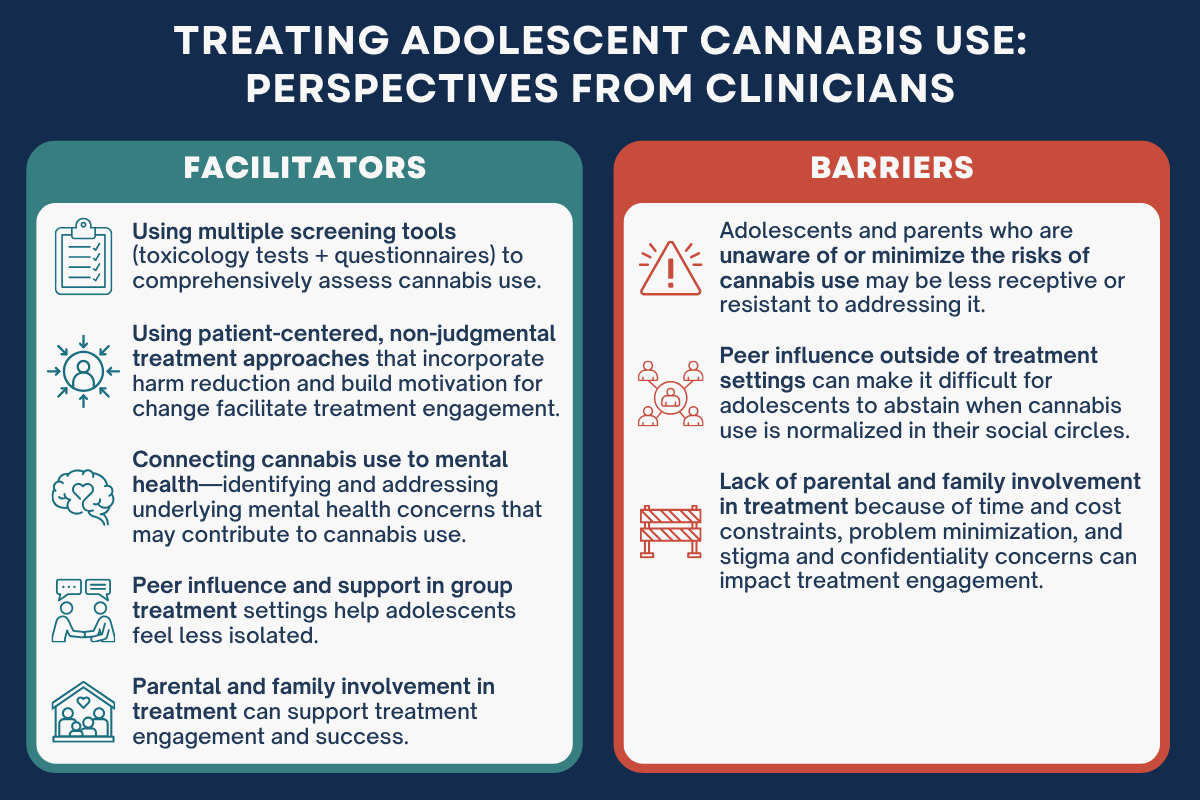Cannabis use is common among adolescents in the United States, with 11.2% of teens (aged 12-17) using cannabis in 2023. Because the adolescent brain is still developing, cannabis use during this time can have unique risks and negative effects such as difficulties with problem-solving, memory, and learning. It’s important for health professionals to be prepared to screen for and treat cannabis use among their adolescent patients. This week, STASH reviews a study by Maha N. Mian and colleagues that investigated barriers and facilitators to addressing adolescent cannabis use in clinical settings.
What was the research question?
What are the barriers and facilitators to treating adolescent cannabis use in clinical settings?
What did the researchers do?
The researchers conducted semi-structured interviews with 32 clinicians1 who provide direct care to adolescents at Kaiser Permanente Northern California. These participants worked a variety of clinical settings—addiction medicine, mental health, emergency department, and pediatrics2. They described their experiences with and typical approaches to screening for and treating cannabis use among their adolescent patients. Using thematic analysis, the researchers identified factors that support treatment (facilitators) and impede treatment (barriers).
What did they find?
The participants identified several facilitators and barriers (see Figure). In terms of facilitators, using multiple screening tools in tandem—such as questionnaires and toxicology tests—provides clinicians with a comprehensive picture of a patient’s cannabis use to guide treatment decisions. Patient-centered, non-judgmental treatment approaches that incorporate harm reduction and build on the patient’s motivation for change can increase willingness to engage with treatment. Clinicians noted that connecting cannabis use to mental health encourages treatment engagement by addressing underlying mental health concerns that could contribute to cannabis use. On the other hand, some adolescents and parents are unaware of or minimize the risks of cannabis, which can make patients less receptive or even resistant to discussing or addressing cannabis use. Finally, peer influence and parental and family involvement in treatment were identified as both facilitators and barriers depending on the context.

Figure. Facilitators and barriers to treating adolescent cannabis use in clinical settings, from the perspective of clinicians who provide direct care to adolescents. Click image to enlarge.
Why do these findings matter?
These findings highlight opportunities for improving how clinicians address cannabis use among adolescent patients. For example, having robust screening processes and emphasizing patient-centered approaches to care can facilitate treatment planning and engagement. Clinicians should consider involving parents and families in treatment, such as during treatment planning or by participating in parallel treatment and support programs like Mar-Anon. Educating adolescents and their families about cannabis use may help address common misconceptions about its risks. This is especially important for adolescents with co-occurring mental health concerns, who may turn to cannabis to cope with underlying issues. Finally, providers should include opportunities for peer support in treatment settings, while simultaneously educating patients on skills to resist peer pressure to use cannabis and other substances.
Every study has limitations. What are the limitations of this study?
This study took place in California, where cannabis is legally available for adult (21+) use. All participants were clinicians working in the same healthcare system. As a result, these findings may not be generalizable to states and countries with different cannabis laws, or to clinical practice in other healthcare systems where policies, procedures, and approaches to addressing cannabis use may differ.
For more information:
Parents and mentors can check out the Partnership to End Addiction’s Marijuana Resource Center for more information on teens and cannabis. If you are worried that you or someone you know is experiencing addiction, the SAMHSA National Helpline is a free treatment and information service available 24/7. For additional self-help tools, visit our Addiction Resources page.
— Kira Landauer, MPH
Want CE credit for reading BASIS articles? Click here to visit our Courses Website and access our free online courses.
________________
1. More than half (56.3%) of the participants identified as female. Additionally, 56.3% identified as White, 15.6% as Asian, 12.5% as Hispanic, 6.3% as Black, and 6.3% as multiracial.
2. In terms of clinical settings, 40.6% of participants were from addiction medicine, 21.9% from the emergency department, 21.9% from mental health, and 15.6% from pediatrics.




